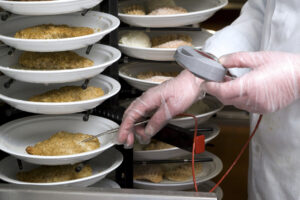[et_pb_section fb_built=”1″ _builder_version=”3.22″][et_pb_row _builder_version=”3.25″ background_size=”initial” background_position=”top_left” background_repeat=”repeat”][et_pb_column type=”4_4″ _builder_version=”3.25″ custom_padding=”|||” custom_padding__hover=”|||”][et_pb_text admin_label=”blog-text” _builder_version=”4.9.9″ custom_margin=”-50px|||” saved_tabs=”all”]
Just started working as a restaurant manager? With great power comes great responsibility – and just like when Peter Parker became Spider-Man, it can be a bit overwhelming. Not only do you have the typical managerial concerns of employees and customers, but dealing with food service, and the tasks that come along with it, take the restaurant manager job to a whole new level.
What makes a good restaurant manager? Well, someone that can think on their feet (literally) and be a proactive problem-solver are good places to start. Never held a manager’s position or looking for a way to improve your current manager’s skillsets? Use EyeSpy’s helpful restaurant management tips as a guide on your journey to manager nirvana:
Manage Proactively
In the restaurant industry, things come at you very fast. A good manager is always proactive and looking ahead to spot potential problems. Some of the things a restaurant manager needs to stay on top of include:
- Menu changes and updates
- Staffing needs, like training and compliance
- Inventory
- Marketing campaigns
- Spotting consumer trends
- Technology & POS systems
Prioritize Staff Retention
Restaurant managers and owners say that hiring, training, and retaining staff is their number one problem. Don’t want to deal with that problem? Make staff retention your priority. Constantly having to replace staff is a huge expense of time and resources – in the long run it costs you more to rehire and train than it does to keep good staff onboard. There are proven ways to retain restaurant employees – good managers know them and stick to the formula.
Be Consistent
No two days are ever the same in the restaurant business. Nonetheless, the best restaurant managers take a consistent approach to how they respond to and resolve issues. As a restaurant manager make sure you’re consistent in:
- How you maintain rules and company policies
- How you communicate to vendors and employees
- What your expectations are
Improve the Customer Experience
Eating prepared food isn’t just a convenience, customers want a dining experience. In fact, a recent survey by the National Restaurant Association said 56% of surveyed adults would rather spend money not just on food but a food experience. You might think you’re just managing the prep and delivery of food, but you’re also managing a customer’s eating experience.
Managing your restaurant customer’s experience involves a mix of cleanliness, ambience, friendly staff, competitive prices, unique food, and even comfortable seating. People who are willing to pay to eat out are looking for great eating experiences.
Invest in Marketing
A restaurant can’t live by word-of-mouth alone, marketing your business and advertising is required. You need signs, you need advertising, you need a social media strategy. All these will help you take on, and ultimately conquer competitive markets when you are a brand-new restaurant.
Good restaurant managers have an advertising budget and a consistent, simple message. These two things are vital to making your marketing dollars go further. You also want to follow the following as a marketer:
- Restaurant & food trends
- Demographics (Who eats at your restaurant? Social media ads can work well and have great audience targeting capabilities.)
- Sales (Including peak times and seasons.)
Good restaurant managers know how to juggle all these things to make sure customers leave satisfied and return. If you’re new or just starting, it may be time to refocus and/or rebuild your skillsets and abilities. Like a muscle, you need a sustainable routine, a consistent schedule (and check list) and the drive to make a difference.
It’s a restaurant manager’s job to create unique and memorable dining experiences that get people talking about your restaurant. In the end, customer satisfaction should be the goal for every decision you make.
[/et_pb_text][et_pb_text admin_label=”share this – text” _builder_version=”3.27.4″ saved_tabs=”all”]
Share this
[/et_pb_text][et_pb_social_media_follow admin_label=”social media follow – icons” _builder_version=”3.11″ text_orientation=”center” background_layout=”dark” module_alignment=”right” custom_margin=”|||” animation_style=”slide” animation_direction=”top” border_radii=”on|100%|100%|100%|100%”][et_pb_social_media_follow_network social_network=”facebook” url=”https://www.facebook.com/Eyespy/” _builder_version=”3.11″ background_color=”rgba(0,0,0,0.1)” custom_margin=”|10px||10px||true” custom_margin_tablet=”|10px||10px||true” custom_margin_phone=”|10px||10px||true” custom_padding=”10px|10px|10px|10px|true|true” custom_padding_tablet=”10px|10px|10px|10px|true|true” custom_padding_phone=”10px|10px|10px|10px|true|true” follow_button=”off” url_new_window=”on”]facebook[/et_pb_social_media_follow_network][et_pb_social_media_follow_network social_network=”twitter” url=”https://twitter.com/eyespy_cc/” _builder_version=”3.11″ background_color=”rgba(0,0,0,0.1)” custom_margin=”|10px||10px||true” custom_margin_tablet=”|10px||10px||true” custom_margin_phone=”|10px||10px||true” custom_padding=”10px|10px|10px|10px|true|true” custom_padding_tablet=”10px|10px|10px|10px|true|true” custom_padding_phone=”10px|10px|10px|10px|true|true” follow_button=”off” url_new_window=”on”]twitter[/et_pb_social_media_follow_network][et_pb_social_media_follow_network social_network=”instagram” url=”https://www.instagram.com/eyespy_cc/” _builder_version=”3.11″ background_color=”rgba(0,0,0,0.1)” custom_margin=”|10px||10px||true” custom_margin_tablet=”|10px||10px||true” custom_margin_phone=”|10px||10px||true” custom_padding=”10px|10px|10px|10px|true|true” custom_padding_tablet=”10px|10px|10px|10px|true|true” custom_padding_phone=”10px|10px|10px|10px|true|true” follow_button=”off” url_new_window=”on”]instagram[/et_pb_social_media_follow_network][/et_pb_social_media_follow][/et_pb_column][/et_pb_row][/et_pb_section]







